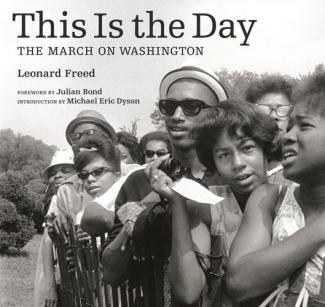
Paul M. Farber (URBS '05) worked with Getty Publications on a book of historic photographs by Magnum photographer Leonard Freed, This Is the Day: The March on Washington, to commemorate the March’s upcoming 50th anniversary, and wrote the afterward for the book.
Paul is nearly finished with his PhD in American Culture at the University of Michigan; his dissertation is a study of representations of the Berlin Wall in American literature, art, and popular culture from 1961–present. In 2012-2013, we are pleased to have Paul come back to Urban Studies as a lecturer in three courses: The Cultures of Cities: Memory, Monuments, and Urban Space (fall 2012), The Immigrant City: Cultural Traces and Virtual Spaces (spring 2013), and Digital City: Approaches in Urban Memory and Cartography (fall 2013).
For more on This is the Day and Paul see http://www.paulfarber.com/This-Is-the-Day.
Listen to the piece on this book from National Public Radio's Weekend Edition!
This is the Day: The March on Washington
Leonard Freed
Foreword by Julian Bond
Introduction by Michael Eric Dyson
Afterword by Paul Farber
Getty Publications
Forthcoming, February 2013
This Is the Day: The March on Washington is a stirring photo-essay by photographer Leonard Freed documenting the March on Washington for Jobs and Freedom of August 28, 1963, the historic day on which Dr. Martin Luther King Jr. delivered his “I Have a Dream” speech at the base of the Lincoln Memorial. This book commemorates the fiftieth anniversary of the historic march that ultimately led to the passage of the Civil Rights Act of 1964.
Never before published in book form, the seventy-five photographs in this volume were chosen from among the hundreds of images that Freed made in the nation’s capitol before, during, and after the march. These images not only present us with stunning wide-angle views of hundreds of thousands of marchers overflowing the National Mall but also focus on small groups of people straining to see the speakers and on individual faces, each one filled with hope and yearning, epitomized by the beautiful young woman who throws her entire being into singing “We Shall Overcome.”
Accompanying the photographs are a first-hand, backstage account of the preparations leading up to the march by social activist and civil rights leader Julian Bond; an introduction to the importance of the march and Dr. King’s involvement by sociology professor and author Michael Eric Dyson; and an informative discussion of Freed’s approach to the photographic project by scholar Paul Farber.
Leonard Freed (American, 1929–2006) was a pioneer in the genre of socially conscious photojournalism. Freed’s photographs are represented in many public and private collections. His book Black in White America, first published in 1967/68, was reissued by Getty Publications in 2010. Julian Bond helped found the Student Nonviolent Coordinating Committee (SNCC) and is currently professor of history at the University of Virginia in Charlottesville. Michael Eric Dyson is a professor of sociology at Georgetown University and the author of sixteen books, including April 4, 1968: Martin Luther King, Jr.’s Death and How It Changed America (Basic Civitas Books, 2008). Paul Farber is currently completing his doctorate in American Culture at the University of Michigan, Ann Arbor.
